Want to know what learning theory has transformed my teaching?
Do you also want to know how it can do the same for you too?
Oh, and the best bit?
You already know how to do it!
Barak Rosenshine’s “Principles of Instruction” has been gaining a lot of attention in the UK over the last year, and rightly so. However, it doesn’t seem to have made any waves anywhere else.
That’s a lot of teachers missing out on what I believe is the single best piece of education theory out there!
It is easy to assimilate because it helps you streamline and organize your teaching using skills you already have.
By the end of this article, you’ll be buzzing to get back into your classroom!
Who was Barak Rosenshine?
Barak Rosenshine was born on August 13th 1930 in Chicago, Illinois.
He was a high school history teacher originally but stopped actively teaching in 1963 to gain a PhD in Education at Stanford University. After completing his PhD he taught at Temple University for 2 years before moving to the University of Illinois.
It is at the University of Illinois that he taught educational psychology and published many papers, mainly focusing on teacher performance, direct instruction and strategies based on cognitive science.
Whilst at Illinois, Rosenshine first proposed his instructional teaching functions, on which he based his later work on the principles of instruction.
Rosenshine’s Six Instructional Teaching Functions
In 1982 and again in 1986 (with Robert Stevens), Rosenshine, laid out six “instructional functions“.
These functions were determined from prior research of successful teacher training and student achievement programs.
Rosenshine and Stevens looked for commonality between the studies they used. They filtered all their observations down into the following six instructional functions:
- Review, checking previous day’s work (and reteaching if necessary).
- Presenting new content/skills.
- Initial student practice (and checking for understanding).
- Feedback and correctives (and re-teaching if necessary).
- Student independent practice.
- Weekly and monthly reviews.
Rosenshine didn’t intend this paper to be the final word on instructional functions, more as an opening gateway to further research. As Rosenshine himself said:
“There’s no hard fast dogma here. It is quite possible to make a reasonable list of 4 or 6 or 8 functions; however,these functions are meant
Rosenshine, B. (1982) Teaching Functions in Instructional Programs. National Institute of Education. Washington DC
to serve as a guide for discussing the general nature of effective instruction”.
Roseshine’s Principles of Instruction
As a teacher myself, I recognize that a lot of the pedagogical texts that trainee teachers are presented with have either been superseded or, even worse, debunked as educational myths. While some offer a good basis of guidance, they can be confusing (at least I found them so when I was training).
What we should be teaching new teachers isn’t only (or, even) Vygotsky, Piaget and Bloom, but something that makes more sense, is more relevant and something that is based on actual research.
Where on Earth would we find such pedagogical genius?
Well, it turns out its been here, in various forms, all along.
In my teacher training, it took me countless hours pouring over Piagetian and Vygotskian theories, trying to work out what on the hell they were talking about. Have they led me to teaching superpowers?
No.
In truth, I haven’t paid them much thought in the 8 years since.
It took me 20 minutes to read Rosenshine’s 2012 paper.
I gained more from that 20 minutes than the sum total of the teacher training research hours/days/millennia (it certainly felt like millennia).
It takes Rosenshine just 9 pages to deliver the golden fleece of pedagogy.
So what is it all about?
The principles of instruction identified by Rosenshine are taken from three areas of research:
- Research in cognitive science.
- Research on the classroom practices of master teachers.
- Research on cognitive support to help students learn complex tasks.
Rosenshine found, that while several of the principles were evident in more than one of the above areas of research, none were contradicted.
Given that all three, very different areas of research supported and complimented Rosenshine’s principles, we can be more inclined to accept their validity.
Like all good Science, his theory has been subject to modification as new understandings were reached.
Rosenshine’s 17 Principles of Effective Instruction
In a paper published in 2010 by the International Academy of Education (IAE); “Principles of Instruction“, Rosenshine expanded on his original list of 6 ideas. These 17 principles were collected from the 3 areas of research above.
- Begin a lesson with a short review of previous learning.
- Present new material in small steps with student practice after each step.
- Limit the amount of material students receive at one time.
- Give clear and detailed instructions and explanations.
- Ask a large number of questions and check for understanding.
- Provide a high level of active practice for all students.
- Guide students as they begin to practice.
- Think aloud and model steps.
- Provide models of worked-out problems.
- Ask students to explain what they have learned.
- Check the responses of all students.
- Provide systematic feedback and corrections.
- Use more time to provide explanations.
- Provide many examples.
- Reteach material when necessary.
- Prepare students for independent practice.
- Monitor students when they begin independent practice.
Rosenshine’s 10 Principles of Instruction
Two years after the IAE paper was published, Rosenshine published a further, revised edition of the paper; “Principles of Instruction: Research-based Strategies that Teachers Should Know“.
In this paper, Rosenshine had, for the sake of clarity (I believe), simplified the list of principles, from a rather ominous 17 down to a more manageable and less intimidating 10.
- Begin the lesson with a review of previous learning.
- Present new material in small steps.
- Ask a large number of questions (and to all students).
- Provide models and worked examples.
- Practize using the new material.
- Check for understanding frequently and correct errors.
- Obtain a high success rate.
- Provide scaffolds for difficult tasks.
- Independent practice.
- Monthly and weekly reviews.
#1 Begin the lesson with a review of previous learning.
Rosenshine suggests investing 5-8 minutes to review previous learning. This can be in the form of questioning techniques to check understanding and to uncover and challenge misconceptions, peer or self-marking work and correcting mistakes. This will strengthen understanding and the connections between ideas.
#2 Present new material in small steps.
Presenting new information in small, bite-sized chunks increases the progress made by the students. Introducing too much at once will see progress rates fall as they can only process so much at one time. This reduction in cognitive load allows metacognition to take place (it allows them to think about how they are thinking about the task).
#3 Ask a large number of questions (and to all students).
Questions are a teacher’s most powerful tool, they can highlight misconceptions, keep a lesson flowing and challenge students to think deeper into a subject. The greatest value of questioning though is that they force students to practice retrieval, this strengthens and deepens memory.
#4 Provide models and worked examples.
Delivering new information to students by linking it to something or some process they are familiar with allows students to gain an understanding quicker, it also gives them deeper retention. This is especially true of more conceptual ideas.
In Science, we may explain the flow of electrons in a circuit by using the model of the water in a “lazy river”. The water being the flow of electrons, the pumps providing the voltage (power) and the people in the water providing resistance.
#5 Practise using the new material.
Practice makes perfect right? Rosenshine postulates that this is true of physical, vocal and mental practice. He suggests that successful teachers allow more time for guidance, questioning and repetition of processes. Actually, in teaching, I prefer to use the phrase “Practice makes Progress”.
#6 Check for understanding frequently and correct errors.
Regular asking of direct questions (rather than “does anyone have any questions?”) allows teachers to check a classes/student’s understanding and catching misconceptions, therefore informing the teacher whether any parts of the topic need reteaching.
#7 Obtain a high success rate.
Teaching for mastery ensures all students in a class are ready to move on to the next stage in the topic, thus preventing students from taking misunderstanding into their future learning.
From his research, Rosenshine found that a class that the optimal success rate is an 80% understanding. This shows that not only have the students learnt the material but also were challenged in doing so. Any higher and the work may not have been challenging enough and vice versa.
#8 Provide scaffolds for difficult tasks.
When introducing a more difficult lesson, Rosenshine suggests employing Vygotskian scaffolding. Providing students with a framework that more easily allows them to make progress.
The scaffolds can then be gradually removed as their competency grows. Examples of scaffolds can include; checklists, cue cards or writing frames. Teachers can also anticipate commonly made errors and build tools into the scaffold tasks that reduce the chances of students making the same mistakes.
#9 Independent practice.
Following scaffolded tasks, students should be competent in the task and therefore can practice the task independently. This repetition of the task will promote a deeper fluency, Rosenshine called this “overlearning”.
#10 Monthly and weekly reviews.
An extension of the first principle, monthly and weekly reviews of previous learning aids recall of information and processes.
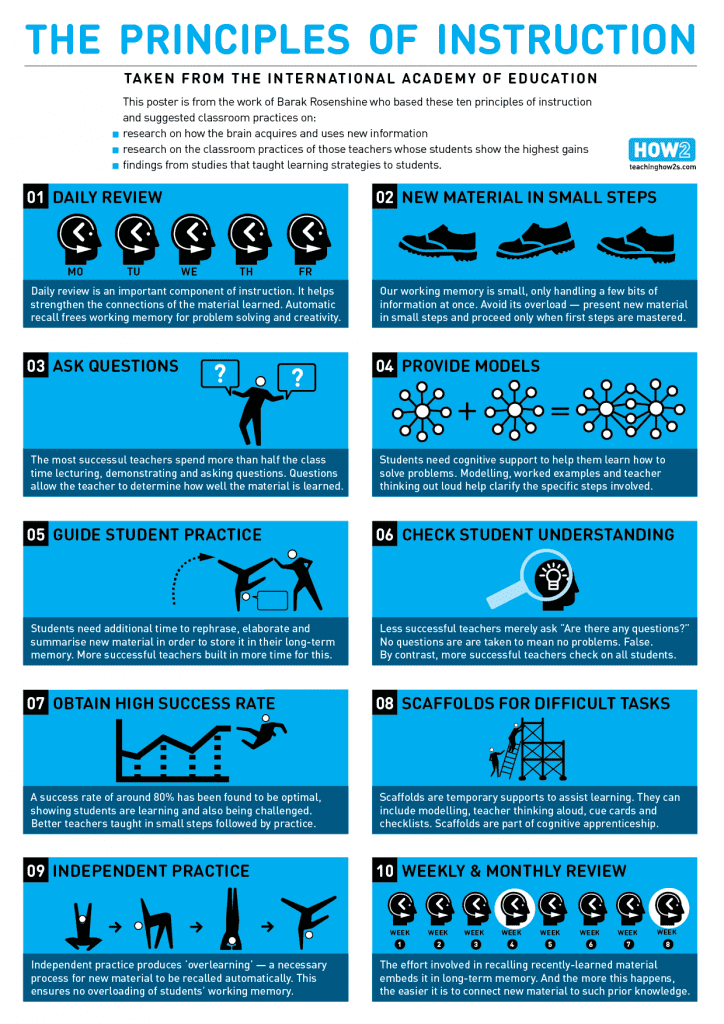
Tom Sherrington: Rosenshine’s Principles in Action
Ex Physics teacher, author and education consultant, Tom Sherrington has become the go-to expert on Rosenshine’s Principles.
He has written about it at length on his blog (teacherhead.com) and his recent short book; “Rosenshine’s Principles in Action” takes Rosenshine’s already excellent paper and makes it even more accessible for today’s teachers.
I’ve included Tom’s researchED talk about Rosenshine’s Principles of Instruction at the bottom of this article, it’s well worth watching.
“My admiration for Rosenshine is largely informed by my experience working with teachers in various schools and colleges where I’ve been trying to engage people with research in order to support them to improve their practice. For me, it is the best, most clear and comprehensive guide to evidence-informed teaching there is.”Tom Sherrington. teacherhead.com
Tom Sherrington’s Four Strands
In Tom’s analysis of Rosenshine’s 10 Principles of instruction, he proposes grouping them into 4 strands that combine connected principles. Sherrington then orders the four strands into a workflow of a lesson.
Strand 1: Sequencing Concepts and Modelling.
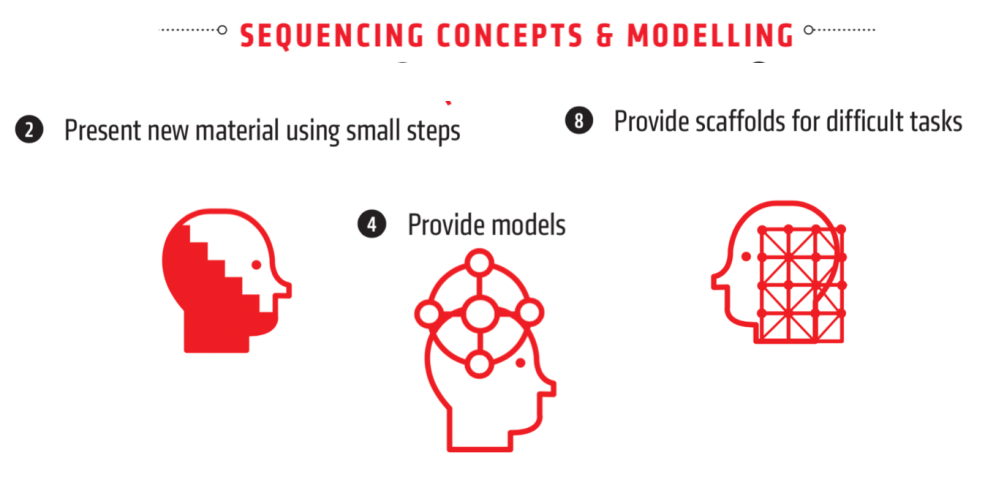
Strand 2: Questioning.
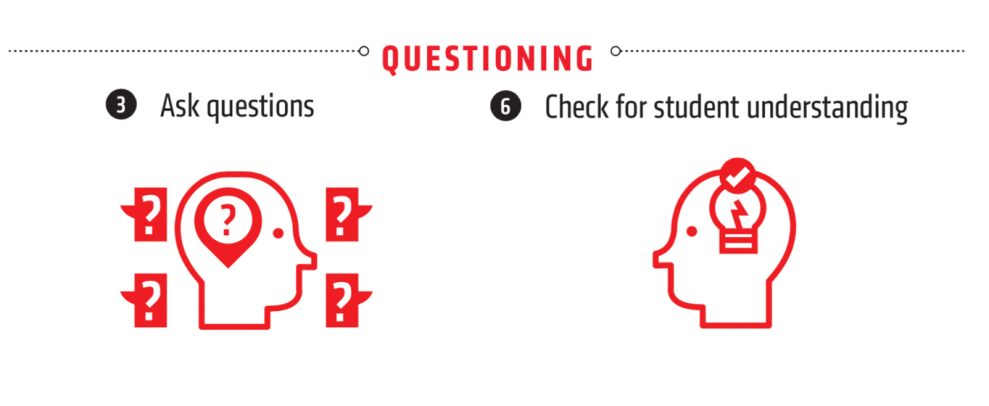
Strand 3: Reviewing Material.
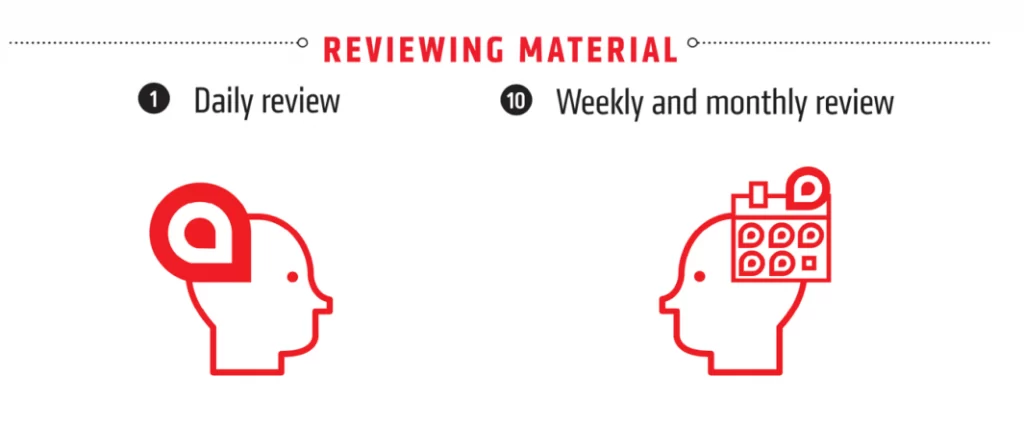
Strand 4: Stages of Practice.
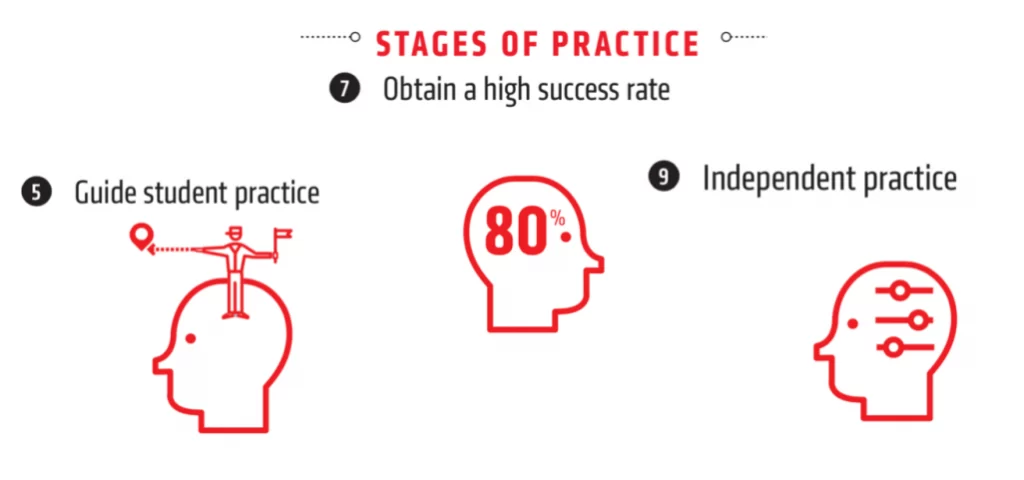
Sherrington is quick to point out that Rosenshine’s work is NOT a checklist that needs to be included in every lesson, but more as a framework that encourages a teacher’s professional development.
(If you like the images in this post, they were created by Oliver Caviglioli who has written about Dual Coding on this website).
Conclusion
Isn’t it Just Common Sense?
This seems to be the most common response from teachers after reading Rosenshine’s paper for the first time.
Well, yes and no.
That’s the beauty of it.
My initial response to it was “I already know that I do it already”
But…
When I thought about my teaching, I saw that I hadn’t really thought about my methods for a while, so I started mapping out a few lessons with Rosenshine’s work in mind.
I was surprised by how my teaching improved.
It may seem like the things we do every day anyway but there is more to it than that (in my opinion). To me, it provides familiar ideas but presents them in a way that allows me to pick and choose the best principles to teach the differing ideas in Science.
That said, it is universally relevant for any subject.
Since I have been using Rosenshine’s principles, I have found that less of my teaching time is wasted, my lessons have become more efficient and students have been making more progress.
But, just remember, it’s not a checklist!
I like to see it as a toolbox, I select the right tool for the job resulting in the job being completed more efficiently.
You wouldn’t eat soup with a fork, would you? You could, but it would take ages!
I urge you to read Rosenshine’s Principles of instruction paper and then look at one the topics you teach and see how you could map it using the 10 principles.
Also, Sherrington’s book is a must-read.

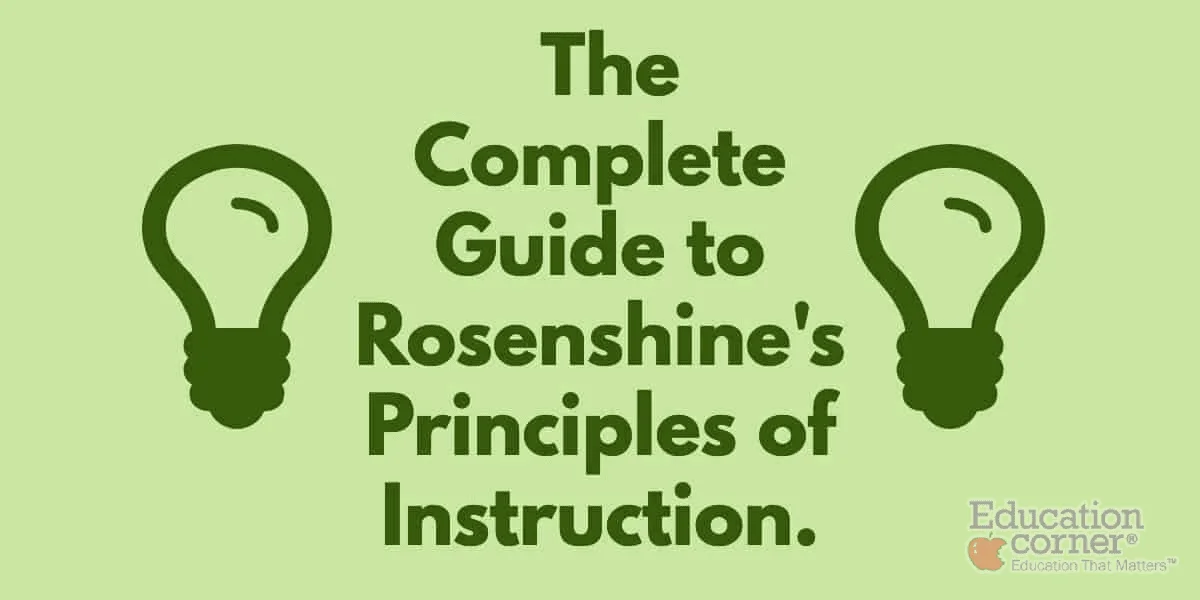
Why is there no reference to Gagne’s Events of Instruction? It aligns perfectly because this is Gagne’s Events of Instruction. There should be a reference to the great thinker: Robert Gagne who came up with this model years ago.